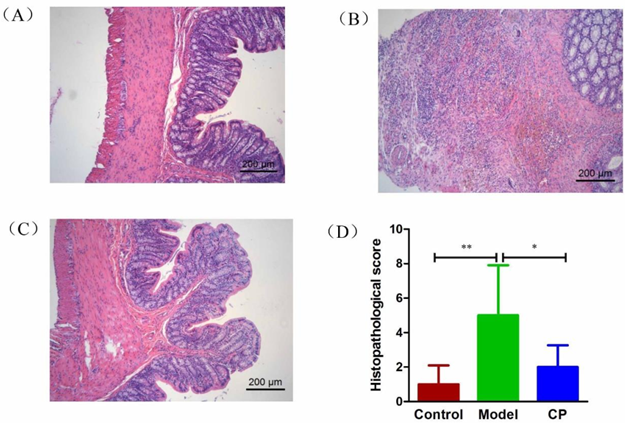- You are here: Home
- Disease Models
- Inflammation & Autoimmune Disease Models
- Inflammatory Bowel Disease Models
- TNBS Induced Colitis Model
Disease Models
- Oncology Models
-
Inflammation & Autoimmune Disease Models
- Rheumatoid Arthritis Models
- Glomerulonephritis Models
- Multiple Sclerosis (MS) Models
- Ocular Inflammation Models
- Sjögren's Syndrome Model
- LPS-induced Acute Lung Injury Model
- Peritonitis Models
- Passive Cutaneous Anaphylaxis Model
- Delayed-Type Hypersensitivity (DTH) Models
- Inflammatory Bowel Disease Models
- Systemic Lupus Erythematosus Animal Models
- Asthma Model
- Sepsis Model
- Psoriasis Model
- Atopic Dermatitis (AD) Model
- Scleroderma Model
- Gouty Arthritis Model
- Carrageenan-Induced Air Pouch Synovitis Model
- Carrageenan-Induced Paw Edema Model
- Experimental Autoimmune Myasthenia Gravis (EAMG) Model
-
Cardiovascular Disease Models
- Surgical Models
- Animal Models of Hypertension
- Venous Thrombosis Model
- Atherosclerosis model
- Cardiac Arrhythmia Model
- Hyperlipoidemia Model
- Doxorubicin-induced Heart Failure Model
- Isoproterenol-induced Heart Failure Model
- Arterial Thrombosis Model
- Pulmonary Arterial Hypertension (PAH) Models
- Heart Failure with Preserved Ejection Fraction (HFpEF) Model
-
Neurological Disease Models
- Alzheimer's Disease Modeling and Assays
- Seizure Models
- Parkinson's Disease Models
- Ischemic Stroke Models
- Acute Spinal Cord Injury (ASCI) Model
- Traumatic Brain Injury (TBI) Model
- Hypoxic-Ischemic Encephalopathy (HIE) Model
- Tourette Syndrome (TS) Model
- Amyotrophic Lateral Sclerosis (ALS) Model
- Huntington's Disease (HD) Model
- Intracerebral hemorrhage (ICH) Models
- Pain Models
- Metabolic Disease Models
- Liver Disease Models
- Rare Disease Models
- Respiratory Disease Models
- Digestive Disease Models
-
Urology Disease Models
- Cisplatin-induced Nephrotoxicity Model
- Unilateral Ureteral Obstruction Model
- 5/6 Nephrectomy Model
- Renal Ischemia-Reperfusion Injury (RIRI) Model
- Diabetic Nephropathy (DN) Models
- Passive Heymann Nephritis (PHN) Model
- Adenine-Induced Chronic Kidney Disease (CKD) Model
- Kidney Stone Model
- Doxorubicin-Induced Nephropathy Model
- Orthopedic Disease Models
- Ocular Disease Models
- Skin Disease Models
- Infectious Disease Models
TNBS Induced Colitis Model
50% ethanol enema containing trinitrobenzene sulfonic acid (TNBS) induced colitis is an economical and time saving model and can simulate clinical features of human inflammatory bowel disease, especially Crohn's disease. In this model, ethanol is used to effectively disrupt intestinal barrier and TNBS is used as a contact-sensitizing allergen to couple with high molecular weight proteins to elicit significant immunologic responses. Numbers of studies by using this model have revealed the pathogenesis of TNBS colitis associated with the function of a key susceptibility gene named NOD2 in Crohn's disease.
Creative Bioarray has many years of experience in the field of colitis and provides pharmacodynamic services for customers to help them assess the efficacy of compounds and study the associated pathological mechanisms of colitis through TNBS- induced colitis model.
Our capabilities
- We utilize TNBS induced colitis model to test the efficacy of drug candidates targeting IBD.
- We assess the severity of colitis through clinical analysis including weight loss, diarrhea and occult blood in stool.
- We evaluate various cytokines through IHC, ELISA, etc.
Assays available
- Clinical analysis
- Histopathological evaluation
- Analysis of mRNA and protein levels
- Cytokine/chemokine analysis
- Immunohistochemistry
With extensive experience in the field of IBD, we are confident to help you to overcome any upcoming challenges. Our experts are fully capable of customizing our protocols and assays to meet your specific needs. With our help, we wish to facilitate your research with high efficiency.
Study examples
 Figure. 1. CP attenuates inflammation in TNBS-induced colitis. Effects of CP on the disease activity index (A), MPO activity (B) and the length of the colon (C). The differences in (A), (B) and (C) were analyzed using one-way ANOVA followed by Tukey's post hoc tests (* P < 0.05, **P < 0.01).
Figure. 1. CP attenuates inflammation in TNBS-induced colitis. Effects of CP on the disease activity index (A), MPO activity (B) and the length of the colon (C). The differences in (A), (B) and (C) were analyzed using one-way ANOVA followed by Tukey's post hoc tests (* P < 0.05, **P < 0.01).
 Figure. 2. The pathological section of the colon tissues from rats in the (A) Control groups, (B) Model group, and (C) CP group, and (D) the histological score. The differences in (D) were analyzed using one-way ANOVA followed by Tukey's post hoc tests (* P < 0.05, ** P < 0.01).
Figure. 2. The pathological section of the colon tissues from rats in the (A) Control groups, (B) Model group, and (C) CP group, and (D) the histological score. The differences in (D) were analyzed using one-way ANOVA followed by Tukey's post hoc tests (* P < 0.05, ** P < 0.01).
Quotation and ordering
If you have any special needs or questions regarding our services, please feel free to contact us. We look forward to cooperating with you in the future.
Reference
- Cai Y , et al. Compound polysaccharides ameliorate experimental colitis by modulating gut microbiota composition and function. J Gastroenterol Hepatol, 2018 Dec 27.
For research use only. Not for any other purpose.

